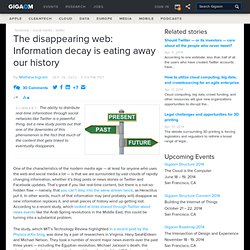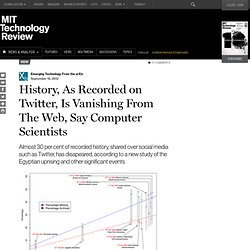

The disappearing web: Information decay is eating away our history. One of the characteristics of the modern media age — at least for anyone who uses the web and social media a lot — is that we are surrounded by vast clouds of rapidly changing information, whether it’s blog posts or news stories or Twitter and Facebook updates.

That’s great if you like real-time content, but there is a not-so-hidden flaw — namely, that you can’t step into the same stream twice, as Heraclitus put it. In other words, much of that information may (and probably will) disappear as new information replaces it, and small pieces of history wind up getting lost. According to a recent study, which looked at links shared through Twitter about news events like the Arab Spring revolutions in the Middle East, this could be turning into a substantial problem.
La disparition de l'information. (Agence Science-Presse) À l’époque de Twitter et de Facebook, l’information est plus fugitive que jamais, c’est bien connu.

À quelle vitesse disparaît-elle? Cliquer sur la photo pour agrandir Un an après des événements majeurs, jusqu’à 11% de ce qui avait eu l’honneur d’un hyperlien sur Twitter a complètement disparu d’Internet. Et un autre 20% est encore là, mais a été archivé à une autre adresse. Les auteurs de cette recherche, à l’Université Old Dominion, en Virginie, ont défini comme «événements majeurs» la révolution égyptienne, le virus H1N1, la mort de Michael Jackson et autres menues excitations des trois dernières années.
Ils se sont contentés des liens partagés sur Twitter, afin d’avoir une base de comparaison valable —et un échantillon déjà plus que respectable. Après deux ans et demi, c’est pire: près de 30% des textes ou autres références qui avaient fait l’objet d’un hyperlien n’existent plus et 41% ont été archivés. The Disappearing Web: Decay Is Eating Our History. One of the characteristics of the modern media age—at least for anyone who uses the Web and social media a lot—is that we are surrounded by vast clouds of rapidly changing information, whether it’s blog post,s or news stories, or Twitter and Facebook updates.

That’s great if you like real-time content, but there is a not-so-hidden flaw—namely, that you can’t step into the same stream twice, as Heraclitus put it. In other words, much of that information may (and probably will) disappear as new information replaces it, and small pieces of history wind up getting lost. According to a recent study, which looked at links shared through Twitter about news events such as the Arab Spring revolutions in the Middle East, this could be turning into a substantial problem.
The study, which MIT’s Technology Review highlighted in a recent post by the Physics arXiv blog, was done by a pair of researchers in Virginia, Hany SalahEldeen and Michael Nelson. What Does IPhone Have to Do With Robots? How Many Resources Shared on Social Media Have Been Lost? History, As Recorded on Twitter, Is Vanishing From The Web, Say Computer Scientists. On 25 January 2011, a popular uprising began in Egypt that led to the overthrow of the country’s brutal president and to the first truly free elections.

One of the defining features of this uprising and of others in the Arab Spring was the way people used social media to organise protests and to spread news. Several websites have since begun the task of curating this content, which is an important record of events and how they unfolded. That led Hany SalahEldeen and Michael Nelson at Old Dominion University in Norfolk, Virginia, to take a deeper look at the material to see how much the shared were still live.
What they found has serious implications. SalahEldeen and Nelson say a significant proportion of the websites that this social media points to has disappeared. Propagation Organique, Viralité - Spreading Phenomenons. Minority rules: Scientists discover tipping point for the spread of ideas. Scientists at Rensselaer Polytechnic Institute have found that when just 10 percent of the population holds an unshakable belief, their belief will always be adopted by the majority of the society.

The scientists, who are members of the Social Cognitive Networks Academic Research Center (SCNARC) at Rensselaer, used computational and analytical methods to discover the tipping point where a minority belief becomes the majority opinion. The finding has implications for the study and influence of societal interactions ranging from the spread of innovations to the movement of political ideals. "When the number of committed opinion holders is below 10 percent, there is no visible progress in the spread of ideas. It would literally take the amount of time comparable to the age of the universe for this size group to reach the majority," said SCNARC Director Boleslaw Szymanski, the Claire and Roland Schmitt Distinguished Professor at Rensselaer.
Infectious_poster_w1_rgb_72dpi_8bit.png (Image PNG, 1684x2384 pixels)